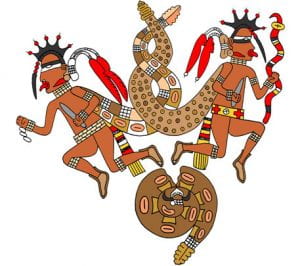Central America
Recorded in writing c. 1554-1558; transcription in K’iche’ and Spanish translation in 18th century
Anonymous
Popol Wuj
(Popol Vuh, Pop Wuj)
“One of the several surviving—in some ways, thriving—highland Maya groups in Guatemala is the K’iche’. Just under a million speakers of Ki’che’ live in Guatemala today. This Popol Wuj we’re handling here is their book, written in their language” (Henne, 14).
My reasons for starting this introduction with these lines from Nathan Henne’s Reading Popol Wuj: A Decolonial Guide (2020) is twofold: to underline that an ethical engagement with Popol Wuj can serve the urgently critical purpose of educating readers about Ki’che’, a “vulnerable language” according to UNESCO, and at the risk of becoming endangered; and to draw attention to Henne’s characterization of the book as belonging to the Ki’che’ speaking peoples. This is their book; therefore, its reading process must include an active awareness of the fact that we’re engaging with indigenous knowledge whose original holders have been historically and violently silenced. As Carlos M. López puts it succinctly, reading this text “is not a simple literary exercise” (69). It is thus critical to be aware of the complex textual history through which we have received this book before we can undertake a reading of the text itself.
Popol Wuj, the closest translations for which are “Council Book” or “Book of Council” [wuj means book], is the title assigned to a transcription and translation of a sixteenth-century manuscript (now lost) of the Maya civilization. It is considered an origin story for K’iche’ peoples. The genesis of its overarching narrative dates back to 300 BCE as hieroglyph forms coupled with oral traditions. In the period between 1554 and 1558, a group of Maya authors collected and compiled a combination of these oral and hieroglyphic narratives in K’iche’ and transliterated it, using Latin alphabet. Twenty years before the start of this effort, “Christianity was formally established in [present-day] Guatemala” by Spanish conquistadors (Christenson, 32). The genocidal, colonialist violence of the Spanish was also epistemic and imperialist, as they forcefully converted the Maya peoples to Christianity, burned their books, and killed the intellectuals and holders of indigenous knowledge. Since hieroglyphs were forbidden by the Spanish colonizers, in order to preserve these narratives, the Mayan authors had to convert the hieroglyphic text to an alphabetic text (Henne, 9). This (now lost) manuscript was later copied and translated by the Dominican friar Francisco Ximénez sometime between 1701 and 1703. Yet Ximénez’s translation may already be compromised since “he undertook his work explicitly to refute Maya-K’iche’ religious idolatry” (Quiroa, 468), which is why one’s reading approach cannot simply be literary, and an accurate and thorough contextualization of it gets us closer to registering “the fundamental question of what it is that the Maya-K’iche’ have presented to us—and what it has become” (ibid.). Ultimately, then, what we have is a copy of a copy or, to use Michael Bazzett’s characterization in introducing his 2018 translation, “a copy of an echo” (viii).
Popol Wuj is one continuous (though not entirely linear) narrative, without any sections or divisions, reflecting the hieroglyphic nature of its origins (see Henne, 25)—any sections or breaks that we see in translated texts, therefore, have been manufactured. The text’s preamble makes reference to the danger that Christendom poses to the continued circulation of the knowledge contained within this text and sets up the book as an attempt to preserve this knowledge. It then proceeds into a primeval creation narrative, wherein the fourth attempt at creating human beings was successful. In the first iteration, they’re built from mud, and in the second iteration, they’re built with wood; the fourth and final, successful version is a combination of water and maize, after a third try with corn which is the closest the creators get to perfection. But after the third attempt is described, there is a narratological break in the text, and the longest component of the text begins: this is a narrative of the genealogy, upbringing, and heroic adventures of two brothers, Junajpu and Ixb’alanq’e, whose success in battles on earth and in the underworld with figures who are trying to disrupt the creation of humans, as well as their efforts to create suitable conditions on earth (including taking their final place in the cosmos as the sun and the moon), allow the creators to complete the fourth and final stage of forming humans beings, after which they proceed to make the first K’iche’ men and women. The final component of the text is a combination of mythical and historical accounts of the first K’iche’ men’s descendants until the Spanish conquest in the sixteenth century.
The text is thus a combination of creation story, mythology, history, and narratives of heroic endeavors that in a Western literary tradition could be categorized as an epic. However, scholars caution us against imposing Western hierarchies of meaning and modes of reading in our approach to Popol Wuj. In his “decolonial [reading] guide,” Henne recommends and carries out comparative analyses of the different existing translations to arrive at meanings that are closer to what the indigenous creators had in mind, by looking at the tensions and overlaps between the different translations.
Two precise and well-researched English translations of Popol Wuj are Dennis Tedlock’s (1985, 1996) and Allen J. Christenson’s (2003, 2004). Michael Bazzett’s 2018 translation eliminates the final, historical component of the narrative, explaining that, “While there is much to be discovered in these pages, I fear my imaginary modern reader would find these lists of names and lineages inaccessible and perhaps confounding without footnotes and further context” (xii).[1] About this omission, Susan D. Gillepsie writes in her review of Bazzett’s translation, “Much of the missing K’iche’ protohistory is as non-literal as forming the first men out of maize. There is no clean break between the “myth” and “history” portions here, a distinction not recognizable by the K’iche’” (289). To quote López once more, “a reading from the Western-dominant perspective implies an inevitable invasion of native discourses which becomes a new form of scholarly colonization” (69). In the case of the aforementioned omission, the dominant perspective would be that in removing a history that seems irrelevant or uninteresting to the reader of Bazzett’s translation, the text’s central meaning(s) would remain untouched. However, as Gillepsie notes, myth and history are interconnected in the Mayan philosophical and literary tradition,[2] thus omissions of this sort distort the text’s worldview. Hence, the importance of reading the text within its own epistemological space and choosing translations that uphold that space.
[1] When discussing this aspect of Bazzett’s translation with my students, I always ask them if they think any translator of Homer’s Iliad would consider omitting the Catalogue of Ships in Book 2.
[2] Henne uses Tedlock’s terminology for this Mayan concept, “mythistory,” and dedicates an entire section to it in his first chapter (see Henne, pp. 31-33).
Atefeh Akbari
Barnard College
Works Cited
Bazzett, Michael, translator. The Popol Vuh: A New English Version. Minnesota: Milkweed Editions, 2018.
Christenson, Allen J., translator. Popol Vuh: The Sacred Book of the Maya. Oklahoma: University of Oklahoma Press, 2007.
Gillespie, Susan D. “The Popol Vuh: A New English Version.” Delos, vol. 34, no. 2, 2019, pp. 285-290,300. ProQuest, doi: http://dx.doi.org/10.5744/delos.2019.1028. Accessed 8 Jan. 2022.
Henne, Nathan C. Reading Popol Vuh: A Decolonial Guide. Tucson: University of Arizona Press, 2020
López, Carlos M. “The Popol Wuj: The Repositioning and Survival of Mayan Culture.” A Companion to Latin American Literature and Culture, edited by Sara Castro-Klaren, Blackwell, 2008, pp. 68-85.
Quiroa, Néstor. “The Popol Vuh and the Dominican Religious Extirpation in Highland Guatemala: Prologues and Annotations of Fr. Francisco Ximénez.” The Americas, vol. 67, no. 4, Cambridge University Press, 2011, pp. 467–94.
Tedlock, Dennis, translator. Popol Vuh: The Mayan Book of the Dawn of Life. Revised edition, Simon and Schuster, 1996.
Resources
Translations:
Bazzett, Michael, translator. The Popol Vuh: A New English Version. Milkweed Editions, 2018.
Christenson, Allen J., translator. Popol Vuh: The Sacred Book of the Maya. University of Oklahoma Press, 2007.
Tedlock, Dennis, translator. Popol Vuh: The Mayan Book of the Dawn of Life. Revised edition, Simon and Schuster, 1996.
Critical studies:
Barrett, Rusty. “Poetics.” The Mayan Languages, edited by Judith Aissen, Nora C. England, and Roberto Zavala Maldonado, Routledge, 2017, 433-457.
Clendinnen, Inga. Ambivalent Conquests: Maya and Spaniard in Yucatan, 15-17-1570. 2nd ed., Cambridge University Press, 2003.
Edmonson, Munro S., translator. The Book of Counsel: The Popol Vuh of the Quiche Maya of Guatemala. Middle America Research Institute, 1971.
Espinosa de los Monteros, Pamela. “Decolonial Information Practices: Repatriating and Stewarding the Popol Vuh Online.” Preservation, Digital Technology & Culture, vol. 48, no. 3-4, 2019, pp. 107-119. ProQuest,
Farriss, Nancy M. Maya Society Under Colonial Rule: The Collective Enterprise of Survival. Princeton University Press, 1984.
Gillespie, Susan D. “Gendering the Hero Twins in the Popol Vuh,” Género y Arqueología en Mesoamérica: Homenaje a Rosemary A. Joyce, edited by María J. Rodríguez-Shadow and Susan Kellogg, Centro de Estudios de Antropología de la Mujer, 2013, 139-151.
—. “The Popol Vuh: A New English Version.” Delos, vol. 34, no. 2, 2019, pp. 285-290, 300. ProQuest.
Gillespie, Susan D. and Ana Lucrecia de MacVean. “Las Flores en el Popol Vuh,” Revista Universidad del Valle de Guatemala vol. 12, December 2002, pp. 10-17.
Henne, Nathan C. Reading Popol Vuh: A Decolonial Guide. Tucson: University of Arizona Press, 2020.
López, Carlos M. “The Popol Wuj: The Repositioning and Survival of Mayan Culture.” A Companion to Latin American Literature and Culture, edited by Sara Castro-Klaren, Blackwell, 2008, 68-85.
Quiroa, Néstor. “Contextualizing the Popol Wuj from Friar Ximénez to the Digital Age.” Oxford Research Encyclopedia of Latin American History, Oxford University Press.
—. “Friar Francisco Ximénez and the Popol Vuh: From Religious Treatise to a Digital Sacred Book,” Ethnohistory, vol. 64, no. 2, pp. 241-270,
—. “Francisco Ximénez and the Popol Vuh: Text, Structure, and Ideology in a Prologue,” CLAHR: Colonial Latin American Historical Review, vol. 11, no. 3, pp. 279-300.
—. “Missionary Exegesis of the Popol Vuh: Maya-K’iche’ Cultural and Religious Continuity in Colonial and Contemporary Highland Guatemala,” History of Religions, vol. 53, no. 1, pp. 66-97
—. “The Popol Vuh and the Dominican Religious Extirpation in Highland Guatemala: Prologues and Annotations of Fr. Francisco Ximénez.” The Americas, vol. 67, no. 4, Cambridge University Press, 2011, pp. 467–94.
Espinosa de los Monteros, Pamela. “Decolonial Information Practices: Repatriating and Stewarding the Popol Vuh Online.” Preservation, Digital Technology & Culture, vol. 48, no. 3-4, 2019, pp. 107-119. ProQuest,
Stavans, Ilan. Popol Vuh: A Retelling. Restless Books, 2020.
The above bibliography was supplied by Atefeh Akbari (Barnard College).
Popol Vuh, Ancient History Encyclopedia

